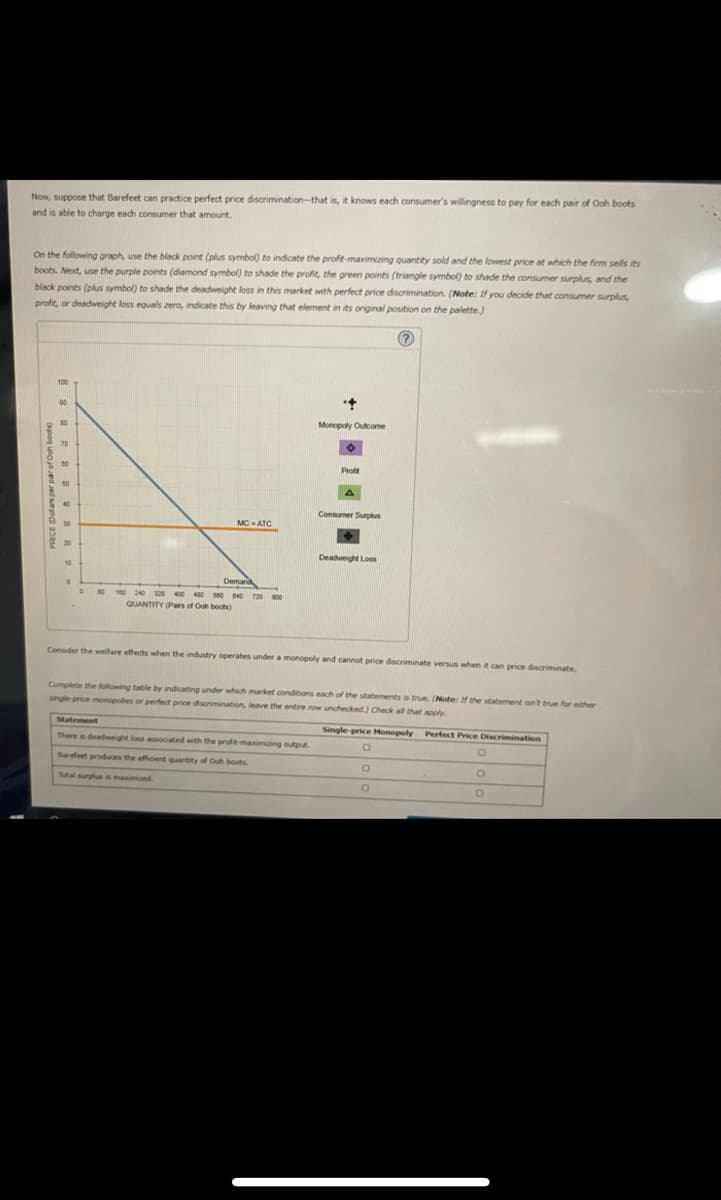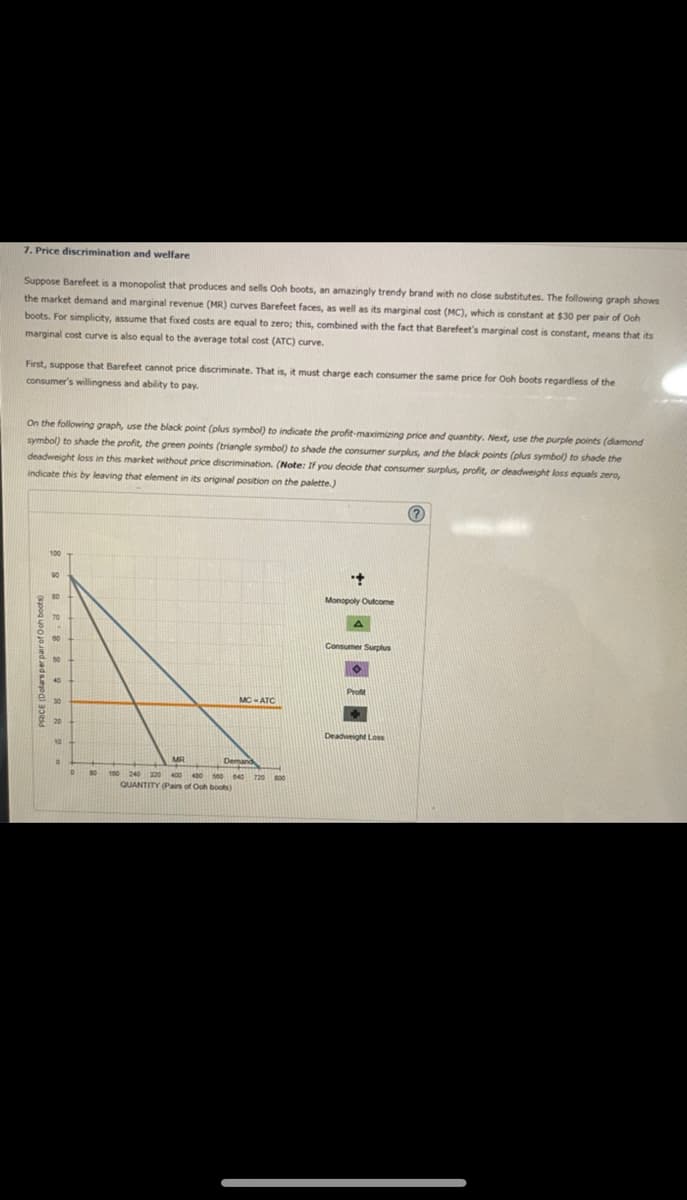7. Price discrimination and welfare Suppose Barefeet is a monopolist that produces and sells Ooh boots, an amazingly trendy brand with no close substitutes. The following graph shows the market demand and marginal revenue (MR) curves Barefeet faces, as well as its marginal cost (MC), which is constant at $30 per pair of Ooh boots. For simplicity, assume that fixed costs are equal to zero; this, combined with the fact that Barefeet's marginal cost is constant, means that its marginal cost curve is also equal to the average total cost (ATC) curve. First, suppose that Barefeet cannot price discriminate. That is, it must charge each consumer the same price for Ooh boots regardless of the consumer's willingness and ability to pay. On the following graph, use the black point (plus symbol) to indicate the profit-maximizing price and quantity. Next, use the purple points (diamond symbol) to shade the profit, the green points (triangle symbol) to shade the consumer surplus, and the black points (plus symbol) to shade the deadweight loss in this market without price discrimination. (Note: If you decide that consumer surplus, profit, or deadweight loss equals zero, indicate this by leaving that element in its original position on the palette.) ? + Monopoly Outcome A Consumer Surplus Deadweight Loss 8822 8 PRICE (Dolars per pair of Ooh boots) 888 8 10 0 MC-ATC MR Demand 240 320 400 400 500 040 720 QUANTITY (Pairs of Ooh boots)
7. Price discrimination and welfare Suppose Barefeet is a monopolist that produces and sells Ooh boots, an amazingly trendy brand with no close substitutes. The following graph shows the market demand and marginal revenue (MR) curves Barefeet faces, as well as its marginal cost (MC), which is constant at $30 per pair of Ooh boots. For simplicity, assume that fixed costs are equal to zero; this, combined with the fact that Barefeet's marginal cost is constant, means that its marginal cost curve is also equal to the average total cost (ATC) curve. First, suppose that Barefeet cannot price discriminate. That is, it must charge each consumer the same price for Ooh boots regardless of the consumer's willingness and ability to pay. On the following graph, use the black point (plus symbol) to indicate the profit-maximizing price and quantity. Next, use the purple points (diamond symbol) to shade the profit, the green points (triangle symbol) to shade the consumer surplus, and the black points (plus symbol) to shade the deadweight loss in this market without price discrimination. (Note: If you decide that consumer surplus, profit, or deadweight loss equals zero, indicate this by leaving that element in its original position on the palette.) ? + Monopoly Outcome A Consumer Surplus Deadweight Loss 8822 8 PRICE (Dolars per pair of Ooh boots) 888 8 10 0 MC-ATC MR Demand 240 320 400 400 500 040 720 QUANTITY (Pairs of Ooh boots)
Principles of Economics (MindTap Course List)
8th Edition
ISBN:9781305585126
Author:N. Gregory Mankiw
Publisher:N. Gregory Mankiw
Chapter15: Monopoly
Section: Chapter Questions
Problem 12PA
Related questions
Question

Transcribed Image Text:Now, suppose that Barefeet can practice perfect price discrimination-that is, it knows each consumer's willingness to pay for each pair of Ooh boots
and is able to charge each consumer that amount.
On the following graph, use the black point (plus symbol) to indicate the profit-maximizing quantity sold and the lowest price at which the firm sells its
boots. Next, use the purple points (diamond symbol) to shade the profit, the green points (triangle symbol) to shade the consumer surplus, and the
black points (plus symbol) to shade the deadweight loss in this market with perfect price discrimination. (Note: If you decide that consumer surplus,
profit, or deadweight loss equals zero, indicate this by leaving that element in its original position on the palette.)
(?)
100
'+
90
Monopoly Outcome
Prof
Consumer Surplus
Deadweight Loss
Deman
80
240 320 400 450 500 540 720 300
QUANTITY (Pairs of Ooh boots)
Consider the welfare effects when the industry operates under a monopoly and cannot price discriminate versus when it can price discriminate.
Complete the following table by indicating under which market conditions each of the statements is true. (Note: If the statement isn't true for either
single-price monopolies or perfect price discrimination, leave the entire row unchecked.) Check all that apply.
Statement
Single-price Monopoly Perfect Price Discrimination
O
There is deadweight loss associated with the profit-maximizing output.
O
Barefeet produces the efficient quantity of Och boots
O
Total surplus is maximized.
O
O
R
10
MC-ATC

Transcribed Image Text:7. Price discrimination and welfare
Suppose Barefeet is a monopolist that produces and sells Ooh boots, an amazingly trendy brand with no close substitutes. The following graph shows
the market demand and marginal revenue (MR) curves Barefeet faces, as well as its marginal cost (MC), which is constant at $30 per pair of Ooh
boots. For simplicity, assume that foxed costs are equal to zero; this, combined with the fact that Barefeet's marginal cost is constant, means that its
marginal cost curve is also equal to the average total cost (ATC) curve.
First, suppose that Barefeet cannot price discriminate. That is, it must charge each consumer the same price for Ooh boots regardless of the
consumer's willingness and ability to pay.
On the following graph, use the black point (plus symbol) to indicate the profit-maximizing price and quantity. Next, use the purple points (diamond
symbol) to shade the profit, the green points (triangle symbol) to shade the consumer surplus, and the black points (plus symbol) to shade the
deadweight loss in this market without price discrimination. (Note: If you decide that consumer surplus, profit, or deadweight loss equals zero,
indicate this by leaving that element in its original position on the palette.)
?
+
Monopoly Outcome
Consumer Surplus
Deadweight Loss
PRICE (Dollars per pair of Ooh boots)
88228 2288 2
0
MR
QUANTITY (Pairs of Ooh boots)
MC-ATC
Demand
500 640 720 800
Expert Solution
This question has been solved!
Explore an expertly crafted, step-by-step solution for a thorough understanding of key concepts.
This is a popular solution!
Trending now
This is a popular solution!
Step by step
Solved in 3 steps with 1 images

Knowledge Booster
Learn more about
Need a deep-dive on the concept behind this application? Look no further. Learn more about this topic, economics and related others by exploring similar questions and additional content below.Recommended textbooks for you

Principles of Economics (MindTap Course List)
Economics
ISBN:
9781305585126
Author:
N. Gregory Mankiw
Publisher:
Cengage Learning

Essentials of Economics (MindTap Course List)
Economics
ISBN:
9781337091992
Author:
N. Gregory Mankiw
Publisher:
Cengage Learning

Principles of Microeconomics (MindTap Course List)
Economics
ISBN:
9781305971493
Author:
N. Gregory Mankiw
Publisher:
Cengage Learning

Principles of Economics (MindTap Course List)
Economics
ISBN:
9781305585126
Author:
N. Gregory Mankiw
Publisher:
Cengage Learning

Essentials of Economics (MindTap Course List)
Economics
ISBN:
9781337091992
Author:
N. Gregory Mankiw
Publisher:
Cengage Learning

Principles of Microeconomics (MindTap Course List)
Economics
ISBN:
9781305971493
Author:
N. Gregory Mankiw
Publisher:
Cengage Learning

Principles of Economics, 7th Edition (MindTap Cou…
Economics
ISBN:
9781285165875
Author:
N. Gregory Mankiw
Publisher:
Cengage Learning

Principles of Microeconomics
Economics
ISBN:
9781305156050
Author:
N. Gregory Mankiw
Publisher:
Cengage Learning
